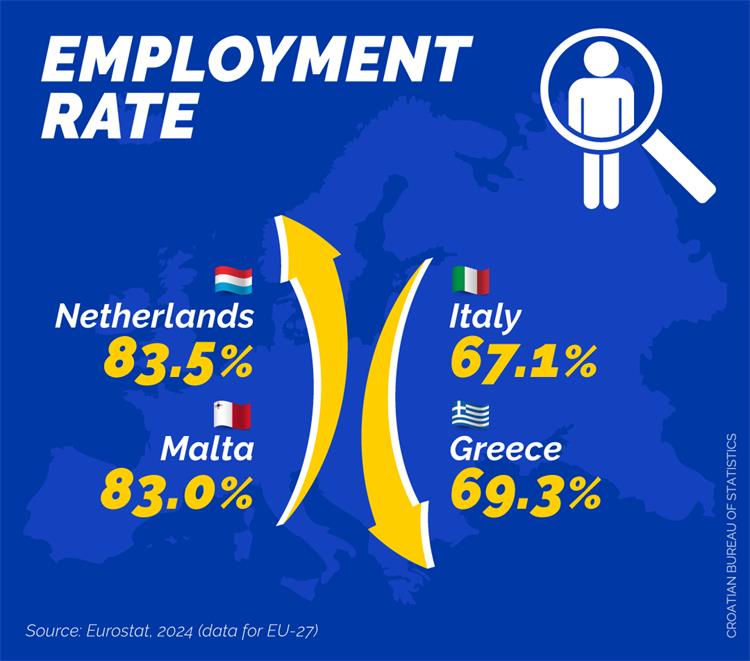- Published: 08.05.2025.
The European Union celebrates 75 years of its existence
Changes in the European Union observed through statistical data
The first steps of European integration were taken back in the last century, specifically on 9 May 1950. Built on strong foundations of solidarity and peace, according to the vision of Robert Schuman, its founding father, the European Union has developed and advanced over the decades. Although driven by the noble goal of uniting Europe in peace and prosperity, the European Union has faced numerous challenges such as globalisation, digital transformation, climate change, the COVID-19 pandemic, and migrations.The transformation of the European Union is best illustrated by numerous reliable, credible, and high-quality statistical data that have been collected, analysed, and interpreted for decades. These data are published in one place by the Statistical Office of the European Union (Eurostat). Therefore, we have prepared the data that reflect the trends and changes within the European Union. Here, we highlight some of the most interesting.
A brief overview of the "growth" of the European Union* can start with data on population count, which, with the accession of new member states, rose to 449.3 million in 2024[1]. Almost half of its total population, specifically 46.9%, is made up of three member states: Germany, France, and Italy. According to the population structure, the share of people aged 0 to 14 years is 14.6%, while the share of people over 65 years old is 21.6%. It is interesting to note that in 1975, the population count of the European Union was 53.5 million lower, with the EU having 395.8 million inhabitants at that time.

One of the indicators of the European Union's economic development is the gross domestic product (GDP) per capita, which in 2024 amounted to EUR 39 680. By comparison, the GDP per capita in 2000 was EUR 18 420, that is, 53.6% lower. For example, in Estonia, a country that joined the EU in 2004, the GDP per capita in 2003 amounted to EUR 6 360, while in 2018 it was EUR 20 040. The financial opportunities provided by the European Union through various funds available to all its member states have contributed to improving citizens' living standards and, in general, to economic growth.
According to Eurostat data, the average annual inflation rate in the European Union in 2024 was 2.6%. The changes in the prices of goods and services for personal consumption in the EU, measured by the harmonised index of consumer prices, are best shown by the following graph. In the observed period, the average annual inflation rate reached its peak in 2022, when it amounted to 9.2%.
Labour market statistics are the subject of many discussions among both experts and laymen. According to the EU Labour Force Survey data, in 2024, the European Union had the highest employment rate (75.8%) since the indicator became available for the age group 20 to 64. The highest employment rates were recorded in the Netherlands (83.5%) and Malta (83.0%), while the lowest were in Italy (67.1%) and Greece (69.3%). On the other hand, the highest unemployment rate in 2024 for the same age group was recorded in two Mediterranean countries - Spain (11.0%) and Greece (10.0%), while the lowest unemployment rates were recorded in the Czech Republic (2.5%) and Poland (2.8%).

In presenting interesting statistical data, we would like to highlight Croatia, which became a full member of the European Union in 2013. EU membership has opened many opportunities for Croatia, including access to grants through EU funds, access to a larger market, and the freedom of movement within member states. A decade of EU membership is described through statistical data that we have prepared in the form of an interactive publication - statistical trends that marked the first 10 years.
Robert Schuman, the French Minister of Foreign Affairs, presented a plan for a united Europe in a declaration that laid the foundations of the European Union as we know it today. Despite the many challenges it has faced over the years, the European Union has remained steadfast in promoting its core values - peace, equality, integration, and democratic cooperation between all member states. We wish the European Union a happy 75th birthday and hope that, in the coming years, it will continue to nurture and promote all its values.
*Source: Eurostat (data for EU-27)
[1] Situation as on 1 January 2024
